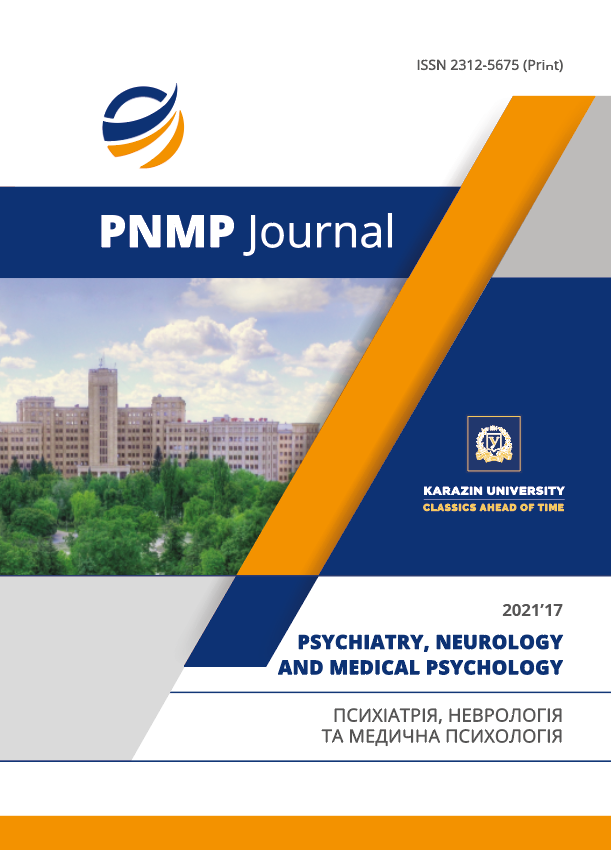Influence of comprehensive physical rehabilitation on the restoration of motor deficiency in patients suffered ischemic stroke
Abstract
The article consideres the issue of restoring lost motor function through comprehensive physical rehabilitation. The results of a study
of 84 patients with cerebral ischemic stroke (CIS) are presented. The study of patients was conducted in the recovery period (from 3 to 6
months after the vascular accident). The average age of patients was 64.2±1.7 years. During the study all patients were divided into two
groups depending on the type of rehabilitation treatment. The main group consisted of 43 patients who received standard medicines
therapy aimed at secondary prevention (antihypertensive, hypocholesterolemic, hypoglycemic and other medicines), as well as therapy
aimed at the correction and prevention of neurocognitive and dyscirculatory disorders (medicines with metabolic and vasoactive action)
during the entire period of supervision. All patients of the main group underwent a course of comprehensive physical rehabilitation
treatment. The latter included classes in kinesiotherapy, occupational therapy, speech therapy classes and, if necessary, patients received
psycho-correctional and psychotherapeutic methods of treatment. The second (comparison) group consisted of 41 patients who received
only drug treatment: standard basic therapy in the framework of secondary prevention of CIS and therapy aimed at the correction and
prevention of neurocognitive, dyscirculatory disorders. The results of our study showed that the use of a comprehensive rehabilitation
treatment program consisting of physical and medical methods are signifi cantly more eff ective for patients with motor disorders who have
suff ered an ischemic stroke compared with the use of only drug therapy in these patients.
Downloads
References
World health statistics 2018: monitoring health for the SDGs, sustainable development goals. ISBN 978 92 4 156558 5 Geneva: World Health Organization; 2018. Licence: CC BY NC SA 3.0 IGO.
Thrift Amanda G. et al. Global stroke statistics. International journal of stroke. 2014. No. 1, pp. 18-32. https://www.doi.org/10.1111/ijs.12245
Mishchenko T.S. Secondary stroke prevention in questions and answers. Health of Ukraine. 2018. No. 1, pp. 20-21. [in Ukr.]
Jonsson Ann-Cathrin et al. Functional status and patient-reported outcome 10 years after stroke. Stroke. 2014. No. 6, pp. 1784-1790. https://www.doi.org/10.1161/STROKEAHA.114005164
Hankey Graeme J. et al. Long-term disability after fi rst-stroke and related prognostic factors in the perth community stoke study, 1989-1990. Stroke. 2002. No. 4, pp. 1034-1040. https://www.doi.org/10.1161/01.str.0000012515.66889.24
Julie Bernhardt et al. Early mobilizizatoon after stroke. Stroke. 2015. No. 4, pp. 1141-1146. https://www.doi.org/10.1161/STROKEAHA.114.007434
Lees Kennedy R. Launching the European stroke journal: The European stroke organization perspective. The European Stroke Journal. 2016. Vol. 1, no. 1, pp. 4-5. https://www.doi.org/10.1177/2396987316630463.
The AVERT Trial Collaboration group. Effi cacy and safety of very early mobilisation within 24h of stroke onset (AVERT): a randomised controlled trial. The Lancet. 2015. Vol. 386, pp. 46-55. https://www.doi.org/10.1016/S0140-6736(15)60690-0
Debble Hebert. Canadian Guidelines for the Management of Stroke Patients Based on Best Practice: A Practical Guide to Post-Stroke Rehabilitation, 2015 Version. International Journal of Stroke. 2017. Vol.1(3), pp. 3-35.
Barkhatov Yu. D., Kadykov A. S. Factors infl uencing the restoration of motor functions in patients with hemispheric cerebral infarction of diff erent localization. Nervous diseases. 2018. No. 4, pp. 41-49. [in Russ.] https://www.doi.org/10.24411/2071-5315-2018-12056
Waje-Andreassen Ulrike, Nabavi D., Engelter S. et al. European Stroke Organisation certifi cation of stroke units and stroke centres. Europen stroke journal. 2018. Vol. 3(3), pp. 220-226. https://www.doi.org/10.1177/2396987318778971
Partridge E. E., E. J. Mayer-Davis et al. Creating a 21st century global health agenda: the General Assembly of the United Nations High Level Meeting on NonCommunicable Diseases. Circulation. 2011. No. 123, pp. 3012-3014. https://www.doi.org/10.1161/CIR.0b013e31821c36ab
Powers W. J., Rabinstein A. A., Ackersen T. et.al. Guidelines for the Early Management of Patients With Acute Ischemic Stroke: A Guideline for Healthcare Professionals From the American Heart Association/American Stroke Association. Stroke. 2018. Vol. 49, no.3, pp. 46–110. https://www.doi.org/10.1161/STR.0000000000000158
Boyd Lara A., Hayward K. S., Ward N. S. et al. Biomarkers of Stroke Recovery: Key Consensus Recommendations from the Stroke Recovery and Rehabilitation Roundtable. International Journal of Stroke. 2018. Vol. 2, no. 1, pp. 5-20.
Bernhardt J., Borschman K. et al. Moving rehabilation research forward: developing consensus statements for rehabilitation and recovery research. International Journal of Stroke. 2016. Vol. 11, no. 1, pp. 454-458. https://www.doi.org/10.1177/1747493016643851
Winters C., Heymans M. W. et al. How to desing clinical rehabilitation trails for the upper paretic lumb early post stroke? Trails. 2016. No. 17, p. 468. https://www.doi.org/10.1186/s13063-016-1592-x
T. Besios, A. Nikolaos, G. Vassilios, M.Giorgos. Eff ects of the Neurodevelopmental Treatment (NDT-Bobath) in the Mobility of Adults with Neurological Disorders. Open Journal of Therapy and Reahabilitation. 2019. Vol. 7, pp. 120-130. https://www.doi.org/10.4236/ojtr.2019.73008
Joong-San Wang, Sang-Bin Lee, Sang-Hyun Moon. The immediate eff ect of PNF pattern on muscle tone and muscle stiff ness in chronic stroke patient. Journal of Physical Therapy Science. 2016. Vol. 28, no. 3, pp. 967- 970. https://www.doi.org/10.1589/jpts.28.967
R. Teasell, N. M Salbach, N. Foley, A Mountain et al. Canadian Stroke Best Practice Recommendations: Rehabilitation, Recovery, and Community Participation following Stroke. Part One: Rehabilitation and Recovery Following Stroke; 6th Edition Update 2019. International journal of Stroke. 2020. Vol. 15, no. 7, pp. 763- 783. https://www.doi.org/10.1177/1747493019897843

